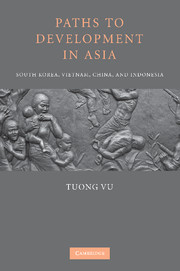Book contents
- Frontmatter
- Contents
- List of Tables and Figure
- Acknowledgments
- List of Abbreviations
- 1 State Formation Dynamics and Developmental Outcomes
- PART ONE DIVERGENT NATIONAL PATHS OF STATE DEVELOPMENT
- PART TWO VARIANTS OF ACCOMMODATION: VIETNAM AND INDONESIA COMPARED
- 6 Organizing Accommodation in Vietnam: Coalition Government, United Front, and Leninist Party
- 7 Organizing Accommodation in Indonesia: Parliament and Status-Based Parties
- 8 Talking Accommodation in Vietnam: Nation, the People, and Class Struggle
- 9 Talking Accommodation in Indonesia: Nation, the People, God, and Karl Marx
- 10 Rethinking Developmental States
- References
- Index
10 - Rethinking Developmental States
Published online by Cambridge University Press: 04 August 2010
- Frontmatter
- Contents
- List of Tables and Figure
- Acknowledgments
- List of Abbreviations
- 1 State Formation Dynamics and Developmental Outcomes
- PART ONE DIVERGENT NATIONAL PATHS OF STATE DEVELOPMENT
- PART TWO VARIANTS OF ACCOMMODATION: VIETNAM AND INDONESIA COMPARED
- 6 Organizing Accommodation in Vietnam: Coalition Government, United Front, and Leninist Party
- 7 Organizing Accommodation in Indonesia: Parliament and Status-Based Parties
- 8 Talking Accommodation in Vietnam: Nation, the People, and Class Struggle
- 9 Talking Accommodation in Indonesia: Nation, the People, God, and Karl Marx
- 10 Rethinking Developmental States
- References
- Index
Summary
In this book I have been concerned with the origins of developmental states. The state is by far the most important of all political institutions, and its role in economic development has long been central in the study of modern politics. However, this book leaves aside policy explanations for rapid economic growth. Nor do I engage in the debate between neoclassical economists and many political economists concerning the appropriate economic roles for states. The literature on developmental states has produced excellent studies that address these issues (e.g., Evans 1995, esp. ch. 2). Rather, I am interested in the structures of these states. The puzzle is, what gives, or gave, successful developmental states their cohesive bureaucracies, centralized government organizations, progrowth class alliances, and firm ideological foundations? This question has rarely been asked in the political economics literature. Cohesive structures do not guarantee that state leaders at any point in time are committed to economic growth. Yet without cohesive state structures, growth-conducive policies are unlikely to generate the intended impact.
In this chapter, I revisit the assumptions underlying my conceptual framework of state formation politics. These assumptions are about elite alignment patterns, the role of foreign forces, and the ability of the framework to predict events. I also consider three implications of this study for understanding developmental states: the role of colonial legacies, the importance of ideologies, and the conditions under which state elites choose to launch developmental policies.
- Type
- Chapter
- Information
- Paths to Development in AsiaSouth Korea, Vietnam, China, and Indonesia, pp. 234 - 252Publisher: Cambridge University PressPrint publication year: 2010

